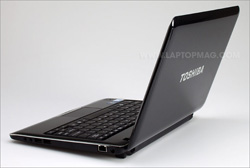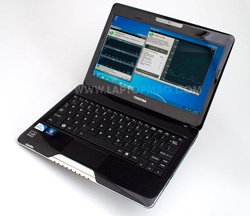Laptop Mag Verdict
This capable ultraportable delivers over 7 hours of battery life, but other systems offer more bang for your buck.
Pros
- +
Long battery life
- +
Attractive design
- +
Strong Wi-Fi performance
- +
Faster than netbooks
Cons
- -
Glossy chassis smudges easily
- -
Slower than competing systems
- -
Stiff touchpad buttons
- -
Long boot time
Why you can trust Laptop Mag
Toshiba's 11.6-inch Satellite T115 ($479) has a lot to offer Windows 7 PC shoppers looking for something that's easy to carry but not too cramped. It soundly outperforms netbooks and lasts nearly a whole work day on a charge. The design could be better, and other systems deliver more oomph for less cash, but this system is worth a look.
Design
Toshiba's wavy, checkered Fusion Finish in Nova Black graces the lid and deck of the 3.4-pound Satellite T115. The look is nice at first glance, but the glossy plastic casing is a terrible fingerprint magnet, so you'll want to keep a cloth handy if you're bothered by smudges. The 11.3 x 8.3 x 1.4-inch notebook is just a hair bigger and heavier than the Acer Aspire 1410. Despite the plastic body, the T115 doesn't feel or look cheap. It struck us as very solid, yet sleek.
The checkered design extends across the touchpad. Beneath that sits a long mouse bar whose design flows into a row of status lights, similar to the larger Satellite U505. The housing for the 6-cell battery raises the unit up about half an inch, resulting in a gentle incline.
Heat
Despite being a thin system, the T115 dissipates heat pretty well.After streaming a Heroes episode from Hulu for 15 minutes, the touchpad registered 94 degrees Fahrenheit, the space between the G and H keys was 90 degrees, and the center of the underside was 98 degrees. While that last reading is on the warm side, the T115 never was uncomfortable while on our lap.
Keyboard and Touchpad
As expected on an 11.6-inch system, the keyboard is close to full size with roomy keys in the center. However, we're disappointed that Toshiba didn't opt to extend the layout to the edge so that keys on the outside left and right could also be full-sized. The right Shift key is shortened--though correctly placed--to cram in dedicated Page Up and Page Down buttons. The Enter key is also smaller than usual, and the Alt and Ctrl keys on the right are so small as to almost be unusable. On the left side the Alt, Fn and Windows keys are all very skinny and not very useful for those who are used to keyboard shortcuts.
Despite the spacing issue, typing on the T115 was comfortable. While typing this review we achieved our normal typing speed after only a few minutes.
Nice and wide, the 3.0 x 1.5-inch touchpad surface on the T115 (practically the same size as the spacious touchpad on the Toshiba mini NB205) is just a little rough, allowing our finger to glide over it effortlessly. We're glad that the touchpad is so wide, as it meant less picking up our finger as we moved across the screen. The T115's touchpad supports multitouch, and we were able to pinch and zoom in Google Chrome with little effort.
The large but unified mouse button on this notebook is a drawback. The bar is nice and long, but we had to use the extreme outer edges to get a good response. It's also somewhat stiff and noisy, but not enough to drive us to an external mouse.
Display and Audio
The glossy, 1366 x 768 pixel display suits the 11.6-inch size well and delivers crisp, bright colors and deep blacks. When watching dark scenes, such as the opening to Torchwood: Children of Earth, the screen kicked back reflections under normal lighting. The bezel surrounding the display is also glossy, which meant that even when we were surfing the Web or typing this review, there were flashes of reflections in the bezel and sometimes on the screen.
The T115's speakers, located under the front edge of the notebook, didn't produce impressive sound. When listening to "One Girl Revolution" by Superchick we heard the distinct bass line, but the audio came out tinny and flat; and volume wasn't great either. We had to hook up external speakers to get passable audio when watching an episode of House via Hulu.
Ports and Webcam
The port spread is what one would expect to find on a netbook-sized system. HDMI and VGA ports line the left side along with a 6-in-1 memory card reader. You'll also find a USB port that can charge such gadgets as smart phones--even when the notebook is in sleep mode or off--on the left side. Two regular USB ports, Ethernet, power, headphone and microphone jacks line the right side.
Passing the cursor over a thin bar at the top left of the T115's screen pulls down a tab for the built-in webcam. Sitting above the display, the 0.3-megapixel camera captured dark images and video, even when under good lighting conditions. We tried adjusting the settings, but we never got a better picture.
Users can set up facial recognition as a login from this tab. We attempted to register our face, but the software had a hard time recognizing us, which caused registration to fail several times.

Click to enlarge

Click to enlarge
Performance

Click to enlargeThe ultra-low voltage 1.3-GHz Intel Pentium processor and 2GB of included RAM notched a PCMark Vantage score of 1,453. That showing beats the netbook average (1,107) but comes in behind other ULV systems, including the $549 Gateway EC1430u (2,700) and the $399 Acer Aspire 1410 (2,475). The biggest difference the T115 and these other two ultraportables as that the Toshiba uses a single-core processor, while the Gateway and Acer machines we reviewed have two cores.
Anecdotally, the T115 didn't lag or slow down while we switched between Microsoft Word and Firefox with eight tabs open while playing music with Windows Media Player, but it's worth noting you can get considerably better performance elsewhere for less money. We were especially annoyed by this system's long boot time. Windows 7 Home Premium booted in 1 minute and 45 seconds, 45 seconds longer than the average.
The 250GB, 5,400-rpm hard drive offers plenty of space for documents and media. It took the T115 4 minutes and 23 seconds to transfer a 4.97GB folder of mixed media for a transfer rate of 19.4 Mbps. That's well behind the Gateway EC1430u (22.2) and the ultraportable average (20.9), but was on a par with the Aspire 1410 (19.6).
When we transcoded a 114MB MPEG-4 video clip to AVI using HandBrake, it took 22 minutes and 16 seconds, which is about 9 minutes longer than the 13:14 category average and close to double that of the Aspire 1410's time of 12:47.
Graphics Performance
Intel's GMA 4500M integrated graphics scored 635 on 3DMark06, which is more than 200 points below the 876 average. However, the T115 doesn't fare as poorly when compared to similar ULV systems. For example, the Acer Aspire 1410 and MSI Wind12 U210 fared worse (595 and 295, respectively).
We would have preferred more graphics power, especially for watching HD video. A 720p clip of The Discoverers from the Windows WMV HD Content Showcase betrayed slight hitches in playback that were only detectable because the scenes move so languidly.
At first, Hulu clips didn't look smooth, even after buffering. But further tests with the beta of Adobe Flash Player 10.1 installed showed a marked performance increase. When we played or streamed four high-definition videos--Legend of the Seeker (720p) and Heroes (480p) on Hulu, a 1080p test clip provided by Nvidia, and a 720p trailer from the new Star Trek movie--we saw frame rates in the low to mid 20s, which is good.
You should also be able to play mainstream games such as World of Warcraft. We saw 22 fps with the resolution at 1024 x 768, but only 6 fps at the maximum resolution of 1366 x 768.
Wi-Fi and Battery Life
The Realtek 802.11b/g/n wireless card's throughput, at 15 feet from the router, was a strong 24.7 Mbps. Above the average ultraportable's score by more than 4 Mbps (20.5), the T115 handily beats the Gateway (20.3) and Acer Aspire 1410 (19.9) at this range. Its 50-foot score of 18.3 Mbps is also strong, again besting the average (17.3) and the Gateway (14.9), coming in just slightly below the Aspire 1410 (18.7).
Running the LAPTOP Battery Test (continuous surfing over Wi-Fi) the T115 lasted 7 hours and 8 minutes, almost 2 hours more than the ultraportable average. This isn't as impressive as the Gateway EC1430u's time (8:11), but the system did last 35 minutes longer than the Aspire 1410 (6:33).
Configurations

Click to enlarge
Besides the configuration of our review unit, the T115-S1105, there are two others. Of note, the T115-S1100 ($449) sports a different ULV processor, the 1.3-GHz Intel Celeron 743, and a b/g only wireless card, but is otherwise identical.
Green Tests
The T115 is pretty eco-friendly, taking 4 hours to fully charge and consuming a total of 7,296 watts during that time. In measuring the LAPTOP Battery Efficiency Rating (total watts divided by battery life; lower is better), the system scored a 17, almost 3 points below the ultraportable average. Compared to other CULV systems, it comes in just below the Acer Aspire Timeline 1810T (17.4) but the Acer Aspire 1410 and Gateway EC1430u both score somewhat better (14.9 and 15.4, respectively).
Software and Warranty
Aside from the facial recognition software, Toshiba bundles a few other branded solutions with the T115. Clicking the My Toshiba icon on the taskbar brings up a quick links window for accessing the User Guide, Toshiba support, online forums and support, plus shortcuts to some of the bundled software. Other notable apps include the ConfigFree utility to help users manage connections, the PC Health Monitor, and the eco utility. This last application allows users to monitor how much energy the T115 is consuming in watts, shows the details of the current power plan, and switches the notebook to eco mode for maximum battery life and energy savings.
Toshiba pre-loads a handful of third-party apps and trial software: Google Toolbar, Intuit QuickBooks Financial Center, Microsoft Works 9, Skype, WildTangent games, a 30-day trial of Norton Internet Security, and a 60-day trial of Microsoft Office Home and Student 2007.
Toshiba backs the T115 with a one-year limited warranty and 24/7 toll-free tech support. To see how Toshiba fared in our Tech Support Showdown, click here.
Verdict
At $479, the 11.6-inch Toshiba Satellite T115-S1105 looks pretty attractive. It doesn't cost that much more than a netbook but offers a larger display and more pep. However, the Acer Aspire 1410 is $80 less and outperforms the T115 on most tests. The 1410 also offers a more comfortable keyboard and a less smudge-prone design. If you want 35 minutes more of battery life and a bit more graphics punch, go with Toshiba's offering.
Toshiba Satellite T115 Specs
| Brand | Toshiba |
| CPU | 1.3-GHz Intel Pentium SU2700 |
| Card Slots | 6-1 card reader |
| Company Website | http://laptops.toshiba.com/ |
| Display Size | 11.6 |
| Graphics Card | Intel GMA 4500M |
| Hard Drive Size | 250GB |
| Hard Drive Speed | 5,400rpm |
| Hard Drive Type | SATA Hard Drive |
| Native Resolution | 1366x768 |
| Operating System | MS Windows 7 Home Premium (32-bit) |
| Ports (excluding USB) | Microphone, Headphone, HDMI, Ethernet, VGA |
| RAM | 2GB |
| RAM Upgradable to | 4GB |
| Size | 11.3 x 8.3 x 1.4 inches |
| USB Ports | 3 |
| Video Memory | 828MB |
| Warranty/Support | One-year limited/24/7 toll-free phone |
| Weight | 3.4 pounds |
| Wi-Fi | 802.11b/g/n |
